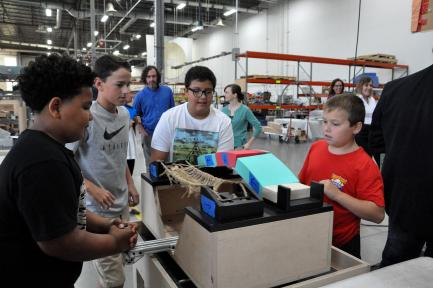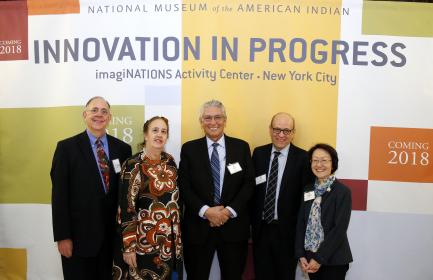National Museum of the American Indian in New York Begins Construction on imagiNATIONS Activity Center
The Smithsonian’s National Museum of the American Indian, George Gustav Heye Center in New York kicks off construction of its imagiNATIONS Activity Center Thursday, Nov. 17. The construction is slated to be completed in late 2017, with a planned public opening in May 2018.
The imagiNATIONS’ educational goal is to demonstrate the influence and impact of Native innovations and technologies on everyday life in ways that will engage visitors and stimulate their thinking—to convey Native innovations that shape how people live. Media interactives, mechanical hands-on activities, handling objects and introductory texts and graphics will also stress the holistic Native American approach to innovation, critical thinking, creative problem solving and sustainability. These are the skills that form the foundation of STEAM-based (Science, Technology, Engineering, Art, Math) educational offerings, and their development is considered essential to social and economic success in the 21st century.
The total projected budget is $9 million, a combination of federal, city, state and private funds.
imagiNATIONS Facts
- Transforms 4,500 square feet of office space to modernized educational, administrative and exhibition space
- Is the product of consultation with several Native experts in STEAM-based education; those consulted will be highlighted in the center to demonstrate the continuity of Native expertise in innovation and technology
- Expands educational offerings to the more than 40,000 K–12 students and educators who visit the Heye Center annually, as well as the museum’s average 500,000 annual visitors
- Serves as a hub for school partnerships, teacher training and cross-cultural collaborations with Native communities through onsite and distance learning
- Features a “Discovery Room” of sample objects for viewing and handling; objects are organized by subject area: Sports, Animal Knowledge, Plant Knowledge, Music, Fiber Technology, Clothing and Adornment, Tools and Transportation
- Facilitates educational activities through its Education Workshop, a dynamic classroom-like space to be used for a variety of purposes, including professional development for teachers, media presentations and distance learning
- Key focal objects include a 15-foot Yup’ik kayak frame and a 26-foot-long Inka grass-rope bridge, in addition to the handling objects in the “Discovery Room”
- Highlights eight distinct areas of educational focus: Native Innovation; Let’s Eat! Nutrition; A-Maize-ing Science; Well-being and Medicine; Zero Mathematics; Make It: Engineering; Solve It: Physics; and Build It: Architecture
*All sections listed are still in drafting phase and may be subject to change.
imagiNATIONS Sections
Native Innovation: Indigenous people of the Americas changed the world with their scientific discoveries and inventions, which continue to influence people’s daily lives. Visitors explore a map of the Americas to learn about many indigenous contributions such as lacrosse, chocolate, varieties of corn and kayaking.
Let’s Eat! Nutrition: For generations, Native Americans harnessed the power of natural grasses, trees, bushes and even cacti to breed edible crops. Today four of the top-10 crops that feed the world—corn, potatoes, cassava and tomatoes—came from Native agriculture.
A-Maize-ing Science: Corn is examined in-depth within the nutrition section, highlighting its many strains and uses, traditionally and in the modern world. Visitors explore corn’s genetic varieties, its hardiness among different climates throughout the Americas, its uses in regard to varying taste and texture and the chemistry practiced by Native groups to make corn more nutritious.
Well-being and Medicine: Many medicines and health-care products have Native American origins. From malaria to the common cold, Native medical knowledge continues to have global impact. Today, indigenous experts and scientists collaborate to find new treatments for a variety of illnesses. The “Medicine Cabinet” reveals the continuity of Native medicinal knowledge found in everyday health-care products.
Zero Mathematics: It is impossible to calculate large numbers without a zero—a numeric symbol that conveys the concept of nothing. Two thousand years ago, the Maya civilization in Mesoamerica was one of only three cultures on Earth to invent the concept of zero. They used a base-20 math system to develop advanced astronomy, calendars and architecture. Within the section, visitors use bars, dots and shells to write and calculate base-20 math problems.
Make It: Engineering: The Inka Empire arose in the Andes Mountains, with rocky gorges too steep and wide to cross. The emperor’s engineers designed hanging bridges made of sturdy grass cable to span these wide distances. The ingenious design of these bridges allows them to better withstand natural disasters such as earthquakes.
Solve It: Physics: Arctic hunters travel miles over snowy landscapes to find prey that hide underwater. It is hard to see, to hear, to travel and, ultimately, to stay alive. Hunters use the physics of light, sound, water and materials to increase their chances of success. Within the section, visitors learn about how Native groups in the Arctic waterproof and weatherproof their clothing and experience sunglasses used by Arctic people thousands of years ago to protect against snow blindness, listen through a paddle to detect a seal swimming underwater and test their balancing ability through a kayak activity.
Build It: Architecture: Climates vary strongly across the Americas, and Native people adapted and innovated their architectural methodology depending on their environment, lifestyles and value systems. Modern architects from across the globe are still learning from indigenous architecture practice. Through mechanical activities, visitors take a deep look at the design principles behind iglus and Pueblo houses/adobe.
About the National Museum of the American Indian
The National Museum of the American Indian, George Gustav Heye Center is located at One Bowling Green in New York City. For additional information, including hours and directions, visit AmericanIndian.SI.edu. Follow the museum via social media on Facebook, Twitter and Instagram.
# # #
SI-517-2016




